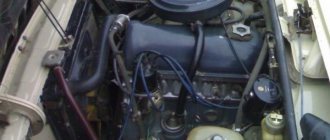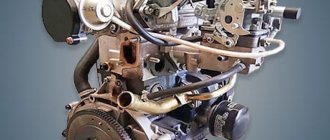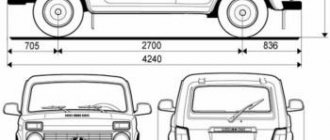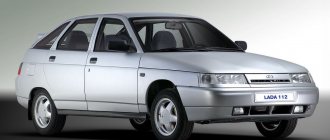Design
VAZ-21053 is the progenitor of the “seven”. Externally, it is very similar to the VAZ-2107, with the exception of the radiator grille. It became the first model in which they strongly decided to abandon chrome (in order to reduce the cost of the design). Thus, the radiator grille was completely black, and the shiny moldings usual for the “Classics” were absent on the body. Other differences include new rectangular headlights with integrated turn signals. Also, other bumpers appeared on the “five”. They were also metal, but more voluminous and lacking “fangs”.
The design of the front side windows has also changed. Previously, the Classic had windows. With the advent of the “five”, the door received solid glass. The design of the rear lights has changed. Otherwise, the body structure remains the same. By the way, initially only 13-inch stamped wheels were offered for the Zhiguli. In the 2000s, 14-inch alloy wheels became available for the VAZ-21053.
Among the disadvantages of this car, owners note the quality of corrosion protection. The car is rotting badly. Therefore, it is not surprising that the “five” could be repainted several times. And touch-ups are completely normal for her. The weak points of the “five” are the sills, bottom and arches. There is no protection against corrosion here. In order to somehow protect against rust, the owners themselves coat the bottom with mastic, treat the thresholds with anti-gravel and other means. Plastic fender liners are also often installed on the car.
Tuning
Recently, the “stens” movement has become increasingly popular. So, the owners tune the VAZ-21053 by installing:
- Classic alloy wheels with a wide shelf.
- Arch extensions.
- JDM style mirrors (placed on the hood).
- “Lips” in the front of the car.
- Spoiler in ducktail style.
The reader can see what the Soviet “five” looks like after this tuning in the photo below.
This car really attracts attention.
VAZ-21053: dimensions, ground clearance
By European standards, the car belongs to the B-class. Thus, the total length of the body is 4.13 meters, width – 1.62, height – 1.45 meters. But it must be said that the length of the wheelbase (2424 millimeters) is very modest even for the B-class. At the same time, the car has impressive ground clearance. On standard 13-inch wheels its size is 17 centimeters. Some owners even raise the rear end. But basically this is not done for cross-country ability (after all, even with standard ground clearance the vehicle could confidently “force” the dirt road), but with the aim of increasing the load capacity. The suspension was very soft and when heavily loaded the rear part sagged a lot.
Why didn't the triumph take place?
The only drawback of the new engine was the short life of the timing belt. It was recommended to change it after 60 thousand km. In fact, the belts “died” even before this period. No catastrophe occurred, except for the fact that the car stopped where the break occurred. Experienced drivers carried a spare copy in the trunk, since replacing the VAZ 2105 timing belt was not too difficult.
Another reason why the engines were considered problematic was the shortage of spare parts characteristic of that time. VAZ 2105 pistons were interchangeable with 21011 parts that did not have counterbores. Sometimes unscrupulous mechanics, either deliberately or due to the lack of regular ones, installed the wrong components.
Naturally, when the belt broke, the valve plates and piston heads entered into a hard “clinch”, and the driver was forced to do a major overhaul of the engine.
A common drawback of all “classic” engines was the need to periodically adjust the valves, and in the first thousand kilometers, also tighten the cylinder head bolts. In addition, the attachments (water pump, starter, generator, distributor) had a short service life. The latter, however, has been absent in recent years due to the use of injection.
One of Murphy's laws states: if there is a part in a device that can be put in reverse, there will always be a person who will do it. This part turned out to be a remote plastic spacer for the fuel pump drive. Signs of its incorrect installation: the engine stalls during acceleration, in the heat, when driving with a lateral roll.
The mounting holes on the spacer flange are located asymmetrically, and the difference is almost invisible to the eye. This “jamb” was present on all “classic” engines, and perhaps migrated back to the FIAT 124. It happened that the spacer was installed upside down at the factory. At the same time, the engine was running, but the stroke of the fuel pump pusher decreased, which led to a decrease in its performance.
After a certain mileage, the level of gasoline in the float chamber barely covered the fuel supply nozzle, and the engine began to stall. Since the cause is quite unexpected, it can sometimes be difficult to determine.
Salon
Inside, the car looks the same as the “four” and “seven”. The driver has a four-spoke steering wheel without any adjustment and a flat fabric seat. The instrument panel on the VAZ-21053 is a pointer panel with modest backlighting. Nevertheless, everything necessary was located here: speedometer, tachometer, fuel level and antifreeze temperature sensor.
By the way, the “five” became the first car among the “Classics”, which was standardly equipped with a heated rear window. In addition, the front door windows have been ventilated in the cabin. However, in order to place deflectors in the panel, it was necessary to reduce the already small-sized glove compartment. The interior here is so simple that the only electronic items are interior lighting and rear window heating. All window regulators are mechanical. The seats are manually adjustable. Among the shortcomings in the interior, the owners note:
- Poor sound insulation. It is very noisy inside, especially at speed, when the roar of the engine can be heard from under the hood.
- Uncomfortable seats. Although they received height-adjustable headrests, they were extremely uncomfortable. There was no lumbar and lateral support. In addition, the seats quickly sank and rubbed. Because of this, you could often see covers on the seats of Zhiguli cars.
- Bad ergonomics. In particular, this concerned the steering wheel and inconvenient controls on the stove.
Five things for which people love and hate the VAZ-2105
“Five” was the last serious attempt to do something on the old VAZ-2101 platform, but at the same time noticeably different from its progenitor. At first she had a lot of “childhood” diseases, but most of them got rid of them over the years of production. However, some “diseases” appeared in later years (Moskvich and Oka ), and what seemed to be a given or design feature, over time turned into a complete inconvenience and archaism. It’s about the same with the advantages of this car: if at first it was valued for its novelty and style, now it is valued for completely different qualities.
In the photo: VAZ-2105 “Zhiguli” '1997–2010
Hate #5: Outdated design
“Five” received almost no laurels, reaped on the fertile soil of retro style - unlike, say, “kopek”, “troika” or “six”. Its style is “cubism”, fashionable in the 1980s, but has not outlived its time, and therefore it is now considered a classic not because of the nostalgia-inducing refined lines of the body or interior, but solely because of its rear-wheel drive. The owners speak about the appearance of the “five”, as well as about the interior design, in the sense that “what can you take from it.” When she first appeared, she looked really cool, but now no one just cares about her looks. So, strictly speaking, this is not even a reason for hatred.
Love #5: Efficient Heater
The excellent “stove”, largely inherited from the VAZ-2101, served the “five” and many other VAZ cars well. The only car in which this stove had difficulty was the aforementioned Oka (due to its two-cylinder engine and large glass area in the interior), but as for the “classics”, all cars of this VAZ family are praised for their warm interior. This is one of those features that makes the “five” a truly Russian car. As does the light aroma of gasoline that penetrates into the cabin through the air ducts along with the warm air.
Hate #4: poor ergonomics and interior comfort
The creators of the VAZ-2105 really tried to add comfort by some means other than a good heater, but too many years have passed since then. Nowadays, the “five” hardly satisfies even the most modest requirements for comfort. Owners complain about the driving position “originally from the 1960s” (it is what it is!), about the front seats themselves (despite the fact that later cars used once-luxury “sevens”), in which it is hardly possible to live tolerably in the slightest degree on a long road, due to the lack of power steering and air conditioning, due to the cramped rear row... In addition to this, on late-production cars, there is a merciless blow at the feet of the rear passenger from the gap between the door and the B-pillar.
Love #4: reliable engine
During the entire production period, the VAZ-2105 was equipped with several engines that were variations of the very first VAZ-2101 engine. At first, the “five” was equipped with a “own” 1.3-liter 69-horsepower engine with a timing belt drive, but the so-called “three” (with the VAZ-2103 index) 1.5-liter 71-horsepower engine took root best on it. with a more reliable (albeit noisier) timing chain. Objectively, this is the most successful “classic” VAZ engine, and the “fives” under the VAZ-21053 symbol were equipped with it until production was completed in 2010. The engine has been somewhat modernized over the years - it switched from a carburetor to multipoint injection and acquired a submersible electric fuel pump in the power system - but it has not lost its main advantages: reliability, service life, low sensitivity to fuel quality and the ability to start in any frost.
Hate #3: Weak chassis components
Once upon a time, all VAZ “classics” were considered almost the standard of “indestructibility”, because a sophisticated Italian sedan once turned into a VAZ “penny”, which, unlike its progenitor, in terms of survival on Russian roads, gave odds to other representatives of the then domestic automobile industry. But the years go by, and everything is learned by comparison: the ball joints of the front suspension and the Panhard rod bracket in the rear are a common headache for many classic drivers.
Love #3: great tuning opportunities
In the photo: Lada Sport VFTS '1982–86
On the other hand, there are a lot of ways to improve any qualities of your “five” - reliability, controllability, cross-country ability. The market is crowded with inexpensive tuning kits for suspension, brakes, steering, transmission, engine... In general, many areas of tuning, amateur sports and just youth fans are based on the VAZ “classics” in Russia: street , drift , BPAN , “combat classics” and other fun .
1 / 3
2 / 3
3 / 3
Hate #2: body corrosion
How imperceptibly this procedure has become a thing of history - immediately after purchase, take the car for a complete anti-corrosion treatment. Most modern cars do not need this, despite the aggressive compounds that are sprayed on the roads, but the “five” needed (and needs) it very much. Although the process of painting “classic” bodies at VAZ has undergone some changes, by today’s standards the corrosion resistance of the VAZ-2105 body is far from excellent. It all starts with banal “saffron milk caps” on the body and ends with through holes in the bottom, sills and wings, which, unlike later VAZ models, cannot simply be removed and replaced with new ones, because they are not screwed on, but welded.
Love #2: low cost of maintenance and repairs
This is why most owners love the “five”. Its design is as simple as possible, spare parts are mostly cheap and completely accessible, so carrying out almost any repair literally in the field, having at your disposal a pair of keys, a screwdriver, a hammer and such and such, is not difficult for a more or less handy motorist.
Hate #1: low reliability
And it has to be repaired often. The comment that describes this point as clearly as possible is: “it can break while standing in the garage.” As we have already said, once they seriously worked on the reliability of the VAZ-2105, ridding it of the flaws of the first years of production, but then these flaws were replaced by low-quality components and failures in the build quality system. Now the reliability of this car is called “lottery” - again, like the Oka, it varies greatly from car to car. And yes, the VAZ-2105 is one of those cars that needs constant care.
Love #1: The perfect car for beginners
But you must admit, this same “constant care” made the cars of the past so attractive, along with their capriciousness, endowing them with character and making them feel almost alive. Yes, the VAZ-2105 breaks down quite often compared to modern cars, but if someone wanted to invent an ideal simulator for a novice motorist, it would have to look and work exactly like this, forcing your growing offspring to understand the features of carburetor settings and learn to adjust valves or change ball valves. Only... all this was great 15 or 10 years ago, but is it necessary now? It is necessary, and how! But not in large cities, where even in the most severe cases you don’t tinker with the engine, but call a tow truck and take the car to a service center.
***
Today, the “five” is not a car for beginners, but rather a car for enthusiasts (that is, motorists in the original sense of the word), and it doesn’t matter whether they are beginners or experienced. And even if among the weak qualities there is no safety or poor handling, with the help of a few smart pieces of hardware you can fix everything, fans of such cars are sure. But among the strengths of this car, we found a statement that the VAZ-2105 drives where, excuse me, wolves are afraid to perform their natural needs. Probably, the author meant cross-country ability, but, objectively speaking, the VAZ-2105 is not very outstanding. In our opinion, this phrase has another meaning: in the modern world, the habitat of the “five” is the province, which in Russia, as is known, is everywhere beyond the ring roads of the two capitals.
Chassis of the “five”
It is almost similar to other classic VAZ models. Thus, an independent spring suspension with transverse swing arms was installed on the front of the car. There is also a stabilizer bar at the front. At the rear there is a spring dependent suspension with longitudinal and transverse bars. The brake system is hydraulic, dual-circuit, with a vacuum booster. Disc brakes are installed at the front, drum brakes at the rear. The handbrake is mechanical, with drive to the rear wheels.
As reviews note, the suspension on the “five” is very soft. It is able to dampen vibrations even at high speeds. But at the same time, the suspension did not tolerate sharp impacts. Due to breakdowns, owners were faced with deformation of the axles of the lower arms. Also, due to the excessively soft suspension, the car took turns poorly and was practically uncontrollable at high speeds. Reviews include all hinge joints as weak points in the chassis. These are steering rods and ball joints. The shock absorbers quickly became unusable due to the large suspension travel. Also, due to low-grade metal, wheel bearings have to be replaced frequently.
At the moment, the VAZ-21053 can be purchased at an average price of 15 to 60 thousand rubles. The condition of the cars will vary, as will the mileage. But the most expensive are the “fresh” copies released in 2010. The price can reach up to 120 thousand rubles.
Main malfunctions of VAZ 2105 engines
If you do not take into account the power plants of the BTM 341 and VAZ 4132, the VAZ 2105 engines are not much different from each other. They have a similar design, and, therefore, they experience the same malfunctions. The main signs that the motor has failed are:
- impossibility of starting it;
- unstable operation at idle;
- violation of normal temperature conditions (overheating);
- power drop;
- change in exhaust color (white, gray);
- the occurrence of extraneous noise in the power unit.
Let's find out what the listed symptoms may indicate.
Inability to start the engine
The power unit will not start if:
- lack of voltage on the spark plugs;
- problems in the power system that prevent the fuel-air mixture from entering the cylinders.
The absence of a spark at the spark plug electrodes may be due to a malfunction:
- the candles themselves;
- high-voltage wires;
- ignition distributor;
- ignition coils;
- breaker (for cars with contact ignition);
- switch (for cars with contactless ignition)
- Hall sensor (for cars with a contactless ignition system);
- ignition switch.
Fuel may not flow into the carburetor and from there into the cylinders due to:
- clogged fuel filter or fuel line;
- fuel pump malfunction;
- obstruction of the carburetor inlet filter;
- malfunction or incorrect carburetor adjustment.
Unstable operation of the power unit at idle speed
Violation of the stability of the power unit at idle may indicate:
- malfunction of the carburetor solenoid valve;
- failure of one or more spark plugs, breakdown of insulation or violation of the integrity of the current-carrying conductor of a high-voltage wire;
- burning of breaker contacts;
- improper adjustment of the quantity and quality of fuel used to form the fuel-air mixture.
More about the VAZ 2105 ignition system: https://bumper.guru/klassicheskie-modeli-vaz/elektrooborudovanie/zazhiganie/kak-vystavit-zazhiganie-na-vaz-2105.html
Overheat
The normal temperature of a running VAZ 2105 engine is 87–950C. If its performance exceeds the limit of 950C, the engine overheats. This can lead not only to burnout of the cylinder block gasket, but also to jamming of moving parts inside the power unit. The causes of overheating may be:
- insufficient coolant level;
- low-quality antifreeze (antifreeze);
- faulty thermostat (cycling the system in a small circle);
- clogged (clogged) cooling radiator;
- air lock in the cooling system;
- Radiator cooling fan failure.
Reduced power characteristics
Engine power may decrease when:
- use of low-quality fuel;
- incorrectly set timing and ignition timing;
- burning of breaker contacts;
- violation of regulations on the quality and quantity of fuel used to form the fuel-air mixture;
- wear of piston group parts.
Exhaust color change
The exhaust gases of a working power unit look like steam and smell exclusively of burnt gasoline. If thick white (gray) gas comes from the exhaust pipe, this is a sure sign that oil or coolant is burning in the cylinders along with the fuel. Such a power unit will not “live” for a long time without major repairs.
The causes of thick white or bluish exhaust are:
- burnout (breakdown) of the cylinder head gasket;
- damage (crack, corrosion) to the cylinder head;
- wear or damage to piston group parts (cylinder walls, piston rings).
Knocks inside the engine
A working power unit produces many different sounds, which, merging, form a pleasant rumbling, indicating that all components and mechanisms are working harmoniously. But if you hear extraneous noises, in particular knocking, this should alert you. They are a sure sign of a serious malfunction. In an engine, similar sounds can be produced by:
- valves;
- piston pins;
- connecting rod bearings;
- main bearings;
- timing chain.
Valves knock due to:
- unregulated increase in thermal gap;
- wear (fatigue) of springs;
- wear of the camshaft cams.
The knocking of the piston pins usually occurs when the ignition timing is not adjusted. In this case, the fuel-air mixture ignites ahead of time, which provokes detonation.
Faulty connecting rod and main bearings of the crankshaft also cause extraneous noise in the engine. When they wear out, the gap between the moving elements of the crankshaft increases, which causes backlash, accompanied by a high-frequency knock.
As for the timing chain, it can create extraneous sounds if it is stretched and the damper is faulty.
Inexpensive AvtoVAZ model
In 2008-2009, the car was considered the cheapest on the Russian market. For reasons of market conditions, prices were steadily declining, since the demand for the car was insignificant. Its popularity was not helped by its ascetic equipment and lack of accessories that make the car a comfortable means of transportation. In addition, during that period the VAZ-2107 model appeared - a direct competitor to the “five”. Since the unification was almost one hundred percent, it was decided to produce only one of them - the VAZ-2107.
Reviews
Reviews of the VAZ-21053 model have never been enthusiastic. The owners noted shortcomings in the gas distribution system. The camshaft belt drive, which often failed, caused a lot of criticism. During the period when the VAZ-03 and VAZ-06 engine with a chain drive was installed on the car, there were no such complaints.
If there are any positive reviews from car owners, they relate to the area of car repair and maintenance: all consumers note the relatively low prices for spare parts and the possibility of repairs in their own garage.
We're sorry, but the requests coming from your IP address appear to be automated. For this reason, we are forced to temporarily block access to the site.
To continue, please enter the characters from the image in the input field and click "Submit".
Cookies are disabled in your browser
. We will not be able to remember you and correctly identify you in the future. To enable cookies, follow the tips on this page.
VAZ-21053 - technical specifications
- Production - Russia, Volzhsky Automobile Plant in the city of Tolyatti.
- Layout - rear-wheel drive, front-engine.
- Platform - VAZ-2101.
- Number of seats: five-seater.
- The steering wheel position is left-hand.
- Issue - from 1980 to 2009.
- Construction - all-metal, welded.
- Type - sedan, four-door. Reverse lift hood. The trunk lid is hinged, without pneumatics.
- Cylinder displacement is 1452 cc/cm.
- Number of cylinders - 4, in-line arrangement.
- The diameter of the pistons is 79 mm.
- The piston stroke is 80 mm.
- The piston rings are gray cast iron, the upper oil scraper ring is chrome plated.
- Power - 71 l. With. at 5600 rpm.
- Torque - 103/3400 Nm/rpm.
- The fuel mixture supply system is injection, with distributed injection (on the VAZ-21053 the injector was installed selectively, mainly on cars produced in small series).
- Timing gear - overhead camshaft, nitrided hardened cams, bleached.
- The number of valves per cylinder is 2.
- Lubrication is forced under pressure.
- Fuel - A-93 gasoline, leaded.
The gearbox is a four-speed manual.
- 3.75 - first gear;
- 2.30 - second gear;
- 1.49 - third gear;
- 1.00 — fourth (direct) gear;
- 3.87 — reverse gear;
- forward gears - helical profile, constant meshing;
- reverse gears are straight.
Why are modifications difficult?
Increasing the power of a belt-driven motor is much more difficult. For example, when using a humped camshaft, you have to install a split gear. For a 5 engine, it simply does not exist with a belt, that is, you will not be able to set marks. In this case, it is better to change the entire engine or install a conversion kit on the injector.
It is reasonable to carry out deep tuning of the VAZ 21053 engine only for certain creative reasons. Simple modifications to the machine with your own hands can be done without significant financial costs.
For example, if a car engine gets very hot, you can upgrade the power system. At the same time, you will be able to achieve reduced fuel consumption.
Before starting work, you should carefully study the recommendations of professionals and draw up an approximate tuning budget, as well as create an estimate of parts. It is important to determine where the parts are marked and where the marks are. Quite often it turns out that the accumulated money is not enough. Everyone should understand why this happens. When disassembling a vehicle, it usually turns out that it is necessary not only to modify the engine, but also to overhaul the main parts of the body. Also, before performing work, get a diagram or repair book. Regardless of the fact that the markings may be different for different units, you can use the literature for different Zhiguli models.
Chassis
The basic basis for the VAZ-21053 model was the 2101 platform. There were no design changes, except for rearranging the brackets when releasing export modifications with right-hand drive.
The front suspension of the VAZ-21053 is two independent units (left and right), consisting of profiled stamped arms that are attached to the transverse beam using silent blocks. The ends of the levers are connected to the steering axle by means of ball joints. Each pair of levers rests on a steel spiral spring, which, with its upper ring, fits into a special socket mounted in the sides of the engine compartment. A hydraulic shock absorber is installed in the middle of the spiral. Both lever units are connected to each other by a rod, which dampens vibrations and ensures lateral stability of the car.
The rear suspension of the pendulum design consists of trailing arms connecting the underbody to the axle beam. Spring coils along with shock absorbers are also an integral part. The lateral stability of the car is ensured by a special stabilizer beam located behind the rear axle.
Brake system
The VAZ-21053 model was equipped with efficient dual-circuit hydraulics. From the central brake cylinder, pressure was supplied to the front and rear wheels according to a separate scheme. One pipeline connected the cylinder to the left front and right rear wheels, and the other connected the left rear wheel to the right front. This separation provided braking in case of failure of one of the circuits.
The front brakes, non-ventilated disc pads, were driven by a caliper covering the brake disc on both sides. The pistons were equipped with special rubber sealing rings that returned them to their original position after each press on the brake pedal.
The rear brakes, drum type, consisted of two self-adjusting shoes, driven by a hydraulic cylinder. The pads returned to their original position under the action of a spring. The design also included a handbrake mechanism controlled from the interior. The handbrake lever was located in the cabin, between the front seats.
Subcompact car VAZ-21053, photo and description
Since 1999, a collapse in prices began on the Russian automobile market, caused by the 1998 default. The VAZ-21053 model, whose engine left much to be desired in terms of gas distribution parameters and some other characteristics, also suffered from unstable market conditions. Stores selling cars, one after another, refused deliveries. Demand for the VAZ-21053 car, the technical specifications of which have not been updated for years, was moderate, starting in 2000 until the closure of production in 2009. After the Oka minicar was discontinued in November 2008, the Lada-2105 and all its modifications became the cheapest cars on the Russian market.
Description
In 1979, VAZ engineers first presented a new model of the power unit for the VAZ 2105 car. Production of the engine continued until 1994. During the production process, the base model was subjected to repeated modernization.
The engine received an index according to the car brand - VAZ-2105. The main differences from previously produced internal combustion engines were the timing drive, ShPG, and fuel supply system.
The VAZ-2105 is a 1.3-liter gasoline in-line four-cylinder naturally aspirated engine with a power of 64 hp. s and torque 94 Nm.
VAZ-2105
Installed on VAZ cars:
- 2105 /sedan/ (1979-2006);
- 2104 /station wagon/ (1984-2012);
- 21072 /sedan/ (1982-2008).
The cylinder block is cast iron, not lined. The peculiarity was increased resistance to overheating.
Achieved by using special low-alloy cast iron. The cylinders are bored inside the block and honed.
The crankshaft and connecting rods are made according to a standard design.
The configuration of the piston crown has been changed. As a result of its counterbore, bending of the valves and destruction of the cylinder head when meeting the valves as a result of a broken timing belt are eliminated.
The cylinder head is made of aluminum alloy. A camshaft, eight valves, their guides and seats are attached to it. An asbestos gasket impregnated with graphite is installed between the cylinder head and the cylinder block.
Another new feature is that the camshaft is mounted on a special removable bed.
The main highlight of the engine is the timing belt drive.
VAZ-2105 timing belt drive diagram
This innovation was used for the first time on VAZ engines. The engine has become more revving and at the same time less noisy. The disadvantages of the timing belt include the absence of hydraulic compensators, which somewhat complicates the maintenance of the unit.
The carburetor in the fuel supply system has been modernized. Now it has an EPHH valve. As a result, fuel consumption has decreased.
The remaining design changes are not significant and correspond to the classic VAZ engines.
Complete diagram of the internal combustion engine
The simplicity of the motor design ensured its high reliability and durability. With careful care and reasonable operation, major repairs were not required for decades.
Recycling program
The car was not in demand, and the manufacturer had already begun to suffer losses. The situation was smoothed out after the introduction of a recycling program, when the owner of an old car received 50,000 rubles from the state as compensation for melting it down. During this period, all AvtoVAZ models, including the VAZ-21053, again became in demand. Prices rose, and then a balancing act began between the cost of the scrappage certificate and the market value of the car. This continued until the model was removed from the assembly line (2009).
Why did the car attract buyers, albeit few? First of all, the availability of spare parts and components, which were relatively inexpensive. In addition, the attractiveness of the VAZ-21053 for Russians was the possibility of repairing and servicing it on their own (in the garage, on the site, or simply “in the field”). This circumstance somewhat leveled out the low demand for the car, but its prestige on the world market fell hopelessly. The car was no longer equipped with even the most necessary accessories; it got to the point that at the beginning of 2009, the daily mileage counter was removed from the dashboard.
Overhaul of VAZ 21053 engine
If, after making all the necessary adjustments, fuel consumption is still high, you need to prepare for a radical modernization. Engine overhaul allows you to restore technical characteristics, and if you use high-quality parts, you will even be able to improve them. As you understand, the motor can be bored out a little, but we do not recommend doing this. It is better to choose a good piston and replace all gaskets with high-quality branded ones. You can also modify the cylinder head and install new bearings. A major overhaul is a reasonable solution when installing an injector on a car, the circuit of which is designed to operate the engine with normal compression.
In order to carry out a full engine repair, you need to figure out how to dismantle the unit. To do this, you will need a diagram so you can understand which fasteners to unscrew. All fasteners usually have their own markings. A removed motor is easier to repair yourself.
The engine can be sent to a repair plant, where they will not only replace all the parts, but also adjust the carburetor for fuel consumption.











